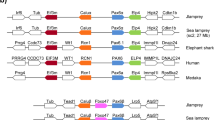Abstract
Pax genes encode transcription factors that are critical regulators of key developmental processes in evolutionarily diverse animal phyla. Here we report the first isolation of a Pax gene from a crustacean: a Pax group III gene we have termed CdpaxIII that contains highly conserved DNA-binding domains, the paired domain and homeodomain. CdpaxIII is expressed in the embryo, in adult limb muscle during both quiescence and regeneration, and during the distinct process of epimorphic limb regeneration. Interestingly, CdpaxIII is expressed as two distinct alternate transcripts, one of which is novel in lacking a large portion of its paired domain.




Similar content being viewed by others
References
Balczarek KA, Lai Z-C, Kumar S (1997) Evolution and functional diversification of the paired box (Pax) DNA-binding domains. Mol Biol Evol 14:829–842
Bertuccioli C, Fasano L, Jun S, Wang S, Sheng G, Desplan C (1996) In vivo requirement for the paired domain and homeodomain of the paired segmentation gene product. Development 122:2673–2685
Burton EM, Mitchell BD (1987) Moult staging in the Australian freshwater crayfish, Cherax albidus Clark and Cherax destructor Clark (Decapoda: Parastacidae), via uropod setal development. Aust J Mar Freshw Res 38:545–552
Cutler LK, Koenders A, Klemm MF, West JM, Mykles DL (2002) Myofibrillar protein composition of muscle fibres from regenerating and pristine claws of the freshwater crayfish Cherax destructor. In: Whisson GJ, Knott B (eds) Freshwater crayfish 13. Proceedings of the thirteenth symposium of the International Association of Astacology. Curtin University, Perth, pp 479–490
Felsenstein J (2002) PHYLIP (Phylogeny Inference Package) version 3.6alpha3. Distributed by the author. Department of Genome Sciences, University of Washington, Seattle
Groger H, Callaerts P, Gehring W, Schmid V (2000) Characterization and expression analysis of an ancestor-type Pax gene in the hydrozoan jellyfish Podocoryne carnea. Mech Dev 94:157–169
Holland LZ, Schubert M, Kozmik Z, Holland ND (1999) AmphiPax3/7, an amphioxus paired box gene: insights into chordate myogenesis, neurogenesis, and the possible evolutionary precursor of definitive vertebrate neural crest. Evol Dev 1:153–165
Pollastri G, Przybylski D, Rost B, Baldi P (2002) Improving the prediction of protein secondary structure in three and eight classes using recurrent neural networks and profiles. Proteins 47:228–235
Sandeman R, Sandeman D (1991) Stages in the development of the fresh-water crayfish Cherax destructor. Roux’s Arch Dev Biol 200:27–37
Seale P, Sabourin LA, Girgis-Gabardo A, Mansouri A, Gruss P, Rudnicki MA (2000) Pax7 is required for the specification of myogenic satellite cells. Cell 102:777–786
Seo H-C, Saetre BO, Havik B, Ellingsen S, Fjose A (1998) The zebrafish Pax3 and Pax7 homologues are highly conserved, encode multiple isoforms and show dynamic segment-like expression in the developing brain. Mech Dev 70:49–63
Vogan KJ, Underhill DA, Gros P (1996) An alternative splicing event in the Pax-3 paired domain identifies the linker region as a key determinant of paired domain DNA-binding activity. Mol Cell Biol 16:6677–6686
Wilson DS, Guenther B, Desplan C, Kuriyan J (1995) High resolution crystal structure of a paired (Pax) class cooperative homeodomain dimer on DNA. Cell 82:709–719
Xu W, Rould MA, Jun S, Desplan C, Pabo CO (1995) Crystal structure of a paired domain-DNA complex at 2.5 Å resolution reveals structural basis for Pax developmental mutations. Cell 80:639–650
Xu HE, Rould MA, Xu W, Epstein JA, Maas RL (1999) Crystal structure of the human Pax6 paired domain-DNA complex reveals specific roles for the linker region and carboxy-terminal subdomain in DNA binding. Genes Dev 13:1263–1275
Acknowledgements
The authors wish to thank Meghan Thomas for assistance with preparation of figures, and Brett O’Brien and Julia Wilson for provision of adult yabbies. This work was completed with support from the Centre for Ecosystem Management, Edith Cowan University.
Author information
Authors and Affiliations
Corresponding author
Additional information
Communicated by C. Desplan
The sequences reported here have been deposited in the GenBank database [accession numbers AY771613 (CdpaxIII) and AY771614 (CdpaxIIIPAID)]
Rights and permissions
About this article
Cite this article
White, R.B., Lamey, T.M., Ziman, M. et al. Isolation and expression analysis of a Pax group III gene from the crustacean Cherax destructor. Dev Genes Evol 215, 306–312 (2005). https://doi.org/10.1007/s00427-005-0478-9
Received:
Accepted:
Published:
Issue Date:
DOI: https://doi.org/10.1007/s00427-005-0478-9




